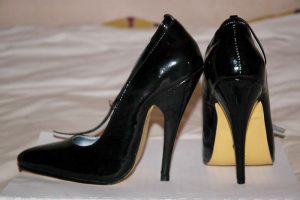 Are workplace codes governing women’s dress simply business regimentation – or the policing/fetishizing/sexualizing of women?
Are workplace codes governing women’s dress simply business regimentation – or the policing/fetishizing/sexualizing of women?
I guess that only the totally obtuse would endorse a mandatory dress code that requires women – and only women — to wear high heels to work. Googling “high heels” for this article, I had to wade through page after page of glitzy ads and articles extolling heels, and many other pages that discuss the medical and safety issues raised by wearing heels.
There is an obvious ambivalence here about high heels at work generally: they are pushed as empowering to women or feminizing, while at the same time they are condemned as being a male-demanded imprisoning or immobilizing (and hurting) of women. Like the binding of girls’ feet in some cultures.

How Filevine Helps In-House Legal Teams Manage Every Matter With Confidence
AI powers tools for data intake, document management, and drafting contracts.
So much ink spilled over this issue, and so many tears shed (from foot pain)…
Who knew that high heels could engender such a vigorous and emotional debate?
The Current Debate Over Mandatory Wearing of High Heels To Work
The UK is in the news these days since a receptionist there, Nicola Thorp, was told by her employer that she had to wear high heels to work. And not just “high heels” – the employer’s dress code required “non-opaque tights … hair with ‘no visible roots’ … ‘regularly re-applied’ makeup — and … shoes with a heel between 2 to 4 inches (5 to 10 centimeters) high.” Now that’s specific – and when Thorpe complained that men were not so burdened, she was sent home without pay.

Pursuing The Pro Bono Story: A Conversation With Alicia Aiken
This Pro Bono Week, get inspired to give back with PLI’s Pursuing Justice: The Pro Bono Files, a one-of-a-kind podcast hosted by Alicia Aiken.
But you don’t mess with Nicola. She started a petition drive that wound up with enough signatures to be eligible for a recent debate in Parliament.
And a hearty Parliamentary debate took place, the result of which is that “the government said the law already specifies that dress codes must be reasonable and make equivalent requirements for men and women. Employers should not be discriminating against women in what they require them to wear.”
Victory?
Last year, a Kansas state senator/committee chairman “issued an 11-point code of conduct to guide women on how to dress. The Topeka Capital-Journal reported that [his] rules don’t include any restrictions on men because, according to [him], men don’t need instructions on how to look professional. … He said he wrote the instruction because provocatively dressed women are a distraction.”
“Oh, for crying out loud, what century is this?” another senator said.
Heels As Status And Power Symbols
Where did the whole idea of high heels come from?
The high heel became a status symbol during the Renaissance, and “by 1580, men wore them, and a person with authority or wealth was often referred to as ‘well-heeled.’”
“Well heeled!” Who knew?
With status/power involved, class and gender are not far behind.
Sociologist Lisa Wade noted that while high heels were “Originally a shoe for high-status men, it was adopted by the lower classes. Elites responded by heightening the heel. The higher the heel, the more impractical the shoe. Eventually the working classes couldn’t keep up with the escalation because they had to, you know, work.”
She noted that “when heels are associated with power, this fits in with dominant ideals of masculinity. When heels are associated with frivolous fashion or superficial erotic value, they are associated with femininity.”
And she quoted another scholar who, when asked whether men would ever again wear heels, said, “Absolutely… If it becomes a signifier of actual power, then men will be as willing to wear it as women.”
Hmmm.
Scrutinizing Women’s Bodies
Invoking the UK heroine mentioned above, Professor Emma Bell observed that “Women are scrutinised far more than men for what they wear and high heels epitomise the lose-lose nature of getting the dress code right. Speaking out against the policy, Thorp said: ‘There is a history behind high heels that has a sexualised element to it. … More column inches are devoted to discussing the dress codes of women political leaders than to scrutinising the sartorial choices of men in equivalent positions of power and authority.’”
Heels As Femininity – “Painful, Impractical and Frivolous”
Sociologist Zuleyka Zevallos added another element to the equation. She noted that “heels become a symbol of femininity for the same reason they were once loved by wealthy European men: they are painful, impractical and frivolous.”
“Men no longer wear heels because social ideas of gender have changed – men are supposed to embody practicality while women are treated as being irrational.”
Heels To Immobilize; Heels As Power And Freedom From Patriarchic Control
So far we have seen heels as symbols of both power/status, as well as femininity, and as sexualizing women for the “scrutiny” of men. Quite a range of meaning.
I found the apparent ambivalence about heels starkly summed up in the following two opposing paragraphs:
(1) “Buzzfeed reports that shoes were used to ‘immobilize women’ starting in Imperial China and the Middle Ages. From torturous foot-binding practices to three-foot-tall platforms, women’s feet have served as a literal representation of female oppression. … Women are also pressured to wear high heels in order to be sexually appealing.”
(2) “But high heels can also be a way for a woman to break free of patriarchal control. … women in the Enlightenment turned to high heels to appear taller and more masculine; they found the shoes lent them a sense of authority. … women today turn to high heels to appear ‘more dominating or powerful in work-related circumstances.’”
So what should a woman at work do?
Heels As … Well, Let’s Just Leave It To Shakespeare and Freud
Let’s cite two men on the street for our finale. Buzzfeed commented that “Puritans in Colonial Massachusetts went so far as to ban high heels, believing that they were lewd. For Shakespeare, women’s feet were vaginal symbols … for Sigmund Freud [not a paragon of feminism], ‘high heels were a vessel to a woman’s genitals.’” Oy vey.
On that note, I’ll pick up my male stilettos and say bye.
 Richard B. Cohen has litigated and arbitrated complex business and employment disputes for almost 40 years, and is a partner in the NYC office of the national “cloud” law firm FisherBroyles. He is the creator and author of his firm’s Employment Discrimination blog, and received an award from the American Bar Association for his blog posts. You can reach him at [email protected] and follow him on Twitter at @richard09535496.
Richard B. Cohen has litigated and arbitrated complex business and employment disputes for almost 40 years, and is a partner in the NYC office of the national “cloud” law firm FisherBroyles. He is the creator and author of his firm’s Employment Discrimination blog, and received an award from the American Bar Association for his blog posts. You can reach him at [email protected] and follow him on Twitter at @richard09535496.